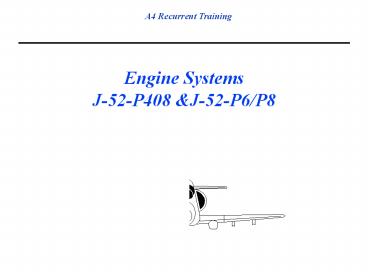Engine Systems J-52-P408 - PowerPoint PPT Presentation
1 / 19
Title:
Engine Systems J-52-P408
Description:
* Fuel Control The engine fuel control is a hydromechanical control. Variables sensed by the fuel control are 1) power lever angle, 2) burner pressure 3) ... – PowerPoint PPT presentation
Number of Views:144
Avg rating:3.0/5.0
Title: Engine Systems J-52-P408
1
Engine SystemsJ-52-P408 J-52-P6/P8
2
Lesson Objectives
- Introduce the major components of the J-52-P408
and the J-52-P8 TURBOJET ENGINE in the A-4N and
TA-4. - To familiarize the Transition Pilot with basic
operation to include - Basic Engine Operation
- Associated ENGINE instruments COCKPIT CONTROLS
- Operational procedures
- Engine Limits
- Emergency Procedures
3
Major Assemblies
4
Inlet Guide Vane (A-4N Only)
5
Engine Anti-Icing System
TA-4
A-4
Right Outboard Wedge Panel
ANTI-ICE Switch
6
J-52-P408/P6 COMPARISON
Note Minimum RPM airborne for P-8 is 70
7
LUBRICATION SYSTEM
8
OIL PRESSURE
9
OIL QUANTITY
10
Oil Press Light INOP
11
A-4 ENGINE IGNITION SYSTEM
The ignition timer energizes the igniters for a
30 to 45 second firing cycle. The momentary
ignition switch, which is used to energize the
ignition timer, is the switch actuated by
movement of the throttle outboard.
12
ENGINE FUEL SYSTEM
-The engine fuel system is designed to permit
selection of desired engine power requirements at
all operating altitudes and temperatures. -The
system has two major components The engine fuel
pump and the fuel control. -Fuel is supplied to
combustion chambers at pressures and flows
necessary to meet these requirements. -Fuel is
supplied from the tanks through necessary
strainers and valves to engine driven fuel
pump. -Fuel then passes through a fuel anti-icing
system installed between the boost and main
stages of the pump and is pumped to fuel control
unit where it is metered in proper
quantities. -Excess fuel is returned to the pump.
13
FUEL ANTI-ICING
-When fuel in the aircraft fuel tanks becomes
severely chilled, icing of the filter may occur,
and obstruct fuel flow. A bypass valve will allow
fuel to bypass filter if filter is
obstructed. -Fuel anti-icing system prevents this
icing condition by automatically warming fuel,
using hot compressor discharge air. -Although
fuel flows through heater at all times, airflow
is prevented unless conditions require fuel
heating. -Fuel temperature sensing element of air
shutoff valve senses and controls fuel
temperature at approximately 50 deg F (10 deg C)
14
(No Transcript)
15
ENGINE FIRE DETECTION SYSTEM
Fire Warning Light
TA-4
A-4N
16
Main Instrument Panel Engine/Fuel
TA-4
A-4N
17
Manual Fuel Light
TA-4
A-4N
18
STARTING THE ENGINE
GROUND CONTROLLED ENGINE START. 1. Pilot holds
one finger vertically--P/C CONNECTS EXTERNAL
POWER AND STARTS GTC 2. ICS--------------------
---------------CHECK 3. Master press-to-test------
----------CHECK 4. Throttle ----------------------
-------OFF 5. Pilot holds two fingers
vertically-P/C OPENS GTC AIR VALVE 6.
Five-percent RPM, throttle--------IGN 7.
Fifteen-percent RPM, throttle-----IDLE 8. At
forty-five-percent RPM, three fingers held
vertically------P/C CLOSE GTC AIR VALVE AND
REMOVE STARTER AIR HOSE 9. Stabilized idle RPM,
pilot holds four fingers vertically-------P/C
SELECTS INTERNAL ELECTRICAL POWER, SECURES
POWER UNIT, REMOVES ELECTRICAL CABLE, SECURES
ACCESS PANEL
19
FLIGHT CREW CHECKLIST REVIEW
- START MALFUNCTIONS
- ENGINE FIRE (GROUND/FLIGHT)
- HIGH/LOW ALTITUDE ENGINE FAILURE AND AIRSTARTS
Note the procedural differences. - CHUGS AND STALLS
- OIL PRESSURE AND QUANTITY MALFUNCTIONS
- FUEL CONTROL MALFUNCTION
- THROTTLE LINKAGE FAILURE
20
START MALFUNCTIONS HUNG HOT WET FALSE
START 1. Throttle OFF (DO NOT ACTUATE
IGNITERS) 2. Engine starter CONTINUE
CRANKING. (15-20 SECS) 3. Engine start
air CUT-OFF
1N
2N
3N
4N
5C
6N
21
CLEARING ENGINE
To clear engine of excess fuel after abnormal
starts 1. Throttle-----------------------OFF
(DO NOT ACTIVATE IGNITERS) 2. Continue to crank
engine with starter for 20 seconds. 3. Engine
start air --------------OFF
22
1N
23
TAKEOFF EMERGENCIES
ENGINE FAILURE DURING TAKEOFF
Throttle----------------------------ENSURE AT
MILITARY 1. Confirmed engine failure---ABORT Abor
t impossible-----------------DECIDE TO EJECT OR
REMAIN WITH AIRCRAFT
24
IN-FLIGHT EMERGENCIES
LOW ALTITUDE LOSS OF THRUST/FLAMEOUT
1. Commence------------------------------------ZO
OM CLIMB 2. Throttle-----------------------------
-----------RETARD 3. Fuel Control----------------
------------------MANUAL 4. Emergency
Generator-----------------------EXTEND If
thrust is not regained immediately, proceed as
follows 5. Throttle-----------------------------
-----------IGN then IDLE 6. Throttle------------
---------------------ADVANCE CAUTIOUSLY and
ascertain restoration of thrust 7. If engine
fails to respond and peak altitude at zoom
apex is LESS THAN 5000 FEET-------------------
-EJECT If time and altitude permit
establish glide----------------------------------2
50 KIAS commence-------------------------------
--------AIRSTART
25
ENGINE FAILURE
1. Throttle--------------------------------------
---RETARD 2. Fuel Control------------------------
-----------MANUAL If Thrust is not regained,
proceed as follows 3. Throttle------------------
-----------------------OFF 4. Emergency
generator-------------------------EXTEND NOTE Ensu
re NORMAL/BYPASS switch NORMAL 5. Check
for---------------------------------------FIRE
IF fire exists or existed-----------------------
NO RESTART
IF NO FIRE proceed as follows 6.
Descend---------------------------------BELOW
30,000 FT 7. Establish glide----------------------
----250 KIAS 8. Throttle--------------------------
--------IGN then IDLE 9. Monitor------------------
----------------RPM EGT 10. IF no relight
(within 45 seconds).--IGN then IDLE
26
FUEL CONTROL MALFUNCTION
1. Throttle--------------------------------MATCH
WITH RPM 2. Fuel control switch------------------M
ANUAL 3. Throttle--------------------------------A
DVANCE SLOWLY TO DESIRED POWER SETTING
27
ENGINE FIRE IN FLIGHT WITH OTHER INDICATIONS
1. Throttle-----------------------OFF 2. Manual
fuel control---------EMER OFF shutoff control
lever 3. Emergency generator-------EXTEND 4.
If fire persists----------------EJECT
IMMEDIATELY 5. If fire goes out---------------DO
NOT RELIGHT ENGINE BUT PERFORM CONTROLLED
EJECTION
28
ENGINE FIRE IN FLIGHT WARNING LIGHT ONLY
1. Throttle-------------------------------MIN
FOR FLIGHT 2. Land as soon as possible.
29
ABNORMAL OIL PRESSURE
1. Less than 1 minute-------PERMISSIBLE 2. If
oil pressure remains out of limits (high or low)
more than 1 Minute---------Maintain (80-82 A-4,
86 - 88 TA-4) ENGINE RPM UNTIL LANDING ASSURED
OR UNTIL DECISION TO EJECT IS MADE 3. USE
PRECAUTIONARY APPROACH.
30
OIL LOW LIGHT ON
1. Abort flight, land at nearest suitable
landing facility. 2. Use Precautionary Approach
for landing
31
THROTTLE LINKAGE FAILURE
1. Do not manipulate throttle. 2. Determine
thrust available, be alert for slow RPM
decay. 3. Fly PA or STA, maintain 180 KIAS
minimum.































